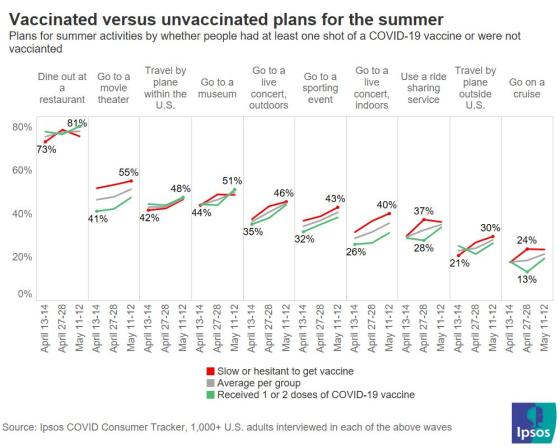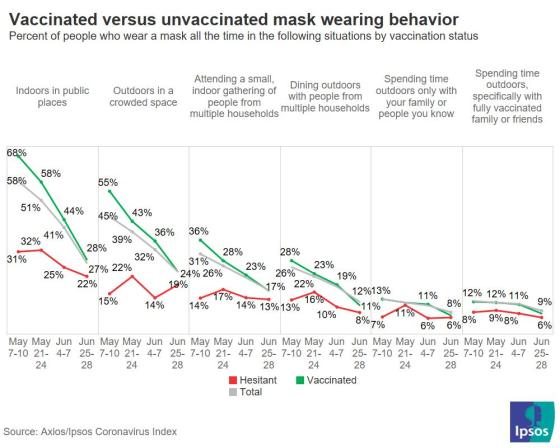To encourage more people to get a COVID-19 vaccine and reach herd immunity, U.S. government leaders and their corporate partners are now dangling many carrots to hesitant Americans. Free childcare, free car rides, even free beer has been offered. But new evidence is emerging in places like Ohio where, after state health authorities set up a lottery offering millions of dollars to people who got the jab, vaccination rates flatlined after an initial bump.
[time-brightcove not-tgx=”true”]
According to our analysis of Ipsos polling, such incentives won’t persuade about a quarter of American adults. And according to the most recent data, Americans—independent of their vaccination status—report phasing out many of the public health precautions they took over the previous 18 months.
Rather than carrots, reaching herd immunity is likely to require the use of sticks: vaccine mandates.
Health officials have left mandates as a last resort to be employed when all who might be persuaded have been vaccinated. But more than half of unvaccinated Americans say they would not get a vaccination if it were readily available to them. And problematically, our polling shows that the choices of those who remain unvaccinated may create enduring risks to public health, which could expedite the spread of mandates in order to secure places like universities, hospitals, and restaurants. This only becomes more urgent with the rise of the more transmissible Delta variant, which has spread to almost every state in the U.S.
Americans who say they do not intend to get vaccinated and those who plan to get vaccinated but have yet to do so are more likely to engage in “risky” activities this summer than people who are already vaccinated.
Perhaps more problematically, these unvaccinated adults are much less likely to wear masks and maintain a safe distance from others compared with people who have already been vaccinated.
This matters because the risk of COVID-19 infections among everyone—even the vaccinated—is dependent on the level of COVID-19 spread in a community. Epidemiologists believe that herd immunity will require between 75 and 85 percent of Americans to be vaccinated. There also remains some uncertainty about the vulnerability of children under the age of 12, who currently cannot be vaccinated.
When the U.S. Centers for Disease Control (CDC) announced on May 13th that Americans fully vaccinated against COVID-19 no longer need to wear masks or physically distance themselves in most indoor and outdoor places, the reversal was based on numerous scientific findings that vaccines would provide enduring protection. However, because “breakthrough” infections depend on how much virus is circulating in a community, the CDC also asked the unvaccinated to take precautions to protect their own health and the health of others.
The new Ipsos data suggest that the unvaccinated are unlikely to hold up their end of the bargain, unless they are compelled to do so.
Unvaccinated adults say they are actually more likely to dine at restaurants, go to movie theaters, attend a sporting event, go to an indoor concert, use a ridesharing service, and go on a cruise this summer—all activities that pose elevated risks of transmission because of close contact with other people.
Despite the risk of contraction and transmission, the unvaccinated are less likely to wear a mask. They are also less likely to say that they have practiced social distancing in the last week.
Of course, this is a mismatch of practices. Those Americans who can now afford to relax the precautions they have taken for 16 months are hesitant to do so, and those who should maintain such precautions say they will not.
As more Americans become vaccinated and since the new CDC guidelines were released, more vaccinated adults have begun to feel comfortable resuming activities previously thought to be too risky and reducing the health precautions they once took. However, polling data suggests that Americans uninterested in the vaccines were less likely to take precautions before they became available anyway, and they are no more likely to do so now.

Numerous studies have shown that this population is disproportionately less educated, lower income, rural, younger, Republican, and supportive of former President Donald Trump—who seeded significant distrust in public health authorities and scientists while in the White House. However, those uninterested in the vaccine already had lower levels of trust in the government and in the vaccine in late 2020 and early 2021, when Trump was still in power. So their behavior is less a reflection of recklessness than it is a result of sustained doubt in the severity of the pandemic and the prescribed actions of government authorities.
Encouragement from the White House—or their preferred beer brewery—is unlikely to move them.
In fact, the U.S.—which innovated several of the world’s most effective vaccines—features among the world’s most skeptical populations. In an Ipsos study of 15 of the world’s largest economies, only Russia features a smaller share of the unvaccinated population who plan to get the jab. U.S. vaccination rates were recently leapfrogged by numerous countries who received delayed access to the medicine.

Once incentives run their course, mandates may be all government institutions and businesses have left at their disposal to end the pandemic in the U.S. The Biden Administration was previously considering issuing a mask-wearing mandate for workplaces, but it is unlikely that the federal government will issue any nationwide mandates for masks or vaccinations. Instead, many businesses and other entities have already started conditioning returns to workplaces and campuses on proof of vaccination.
If the U.S. is to reach herd immunity, the polling suggests they are right to do so.

0 Comments